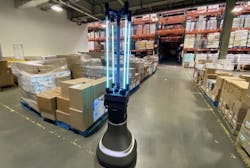As the spread of COVID-19 isn't decreasing but in fact, increasing, there is a need to keep warehouse surfaces free of the droplets that spread the virus.
Trying to solve that problem, a team from MIT’s Computer Science and Artificial Intelligence Laboratory (CSAIL), in collaboration with Ava Robotics and the Greater Boston Food Bank (GBFB), designed a new robotic system that can neutralize aerosolized forms of the coronavirus, as reported by Rachel Gordon in MIT News.
The approach uses a custom UV-C light fixture which was designed at CSAIL and is then integrated with Ava Robotics’ mobile robot base.
While UV-C light has proven to be effective at killing viruses and bacteria on surfaces and aerosols, it’s unsafe for humans to be exposed. Instead of the telepresence top, the team subbed in a UV-C array for disinfecting surfaces. Specifically, the array uses short-wavelength ultraviolet light to kill microorganisms and disrupt their DNA in a process called ultraviolet germicidal irradiation.
During tests at GBFB, the robot was able to drive by the pallets and storage aisles at a speed of roughly 0.22 miles per hour. At this speed, the robot could cover a 4,000-square-foot space in GBFB’s warehouse in just half an hour. The UV-C dosage delivered during this time can neutralize approximately 90% of coronaviruses on surfaces.
Currently, the team is exploring how to use its onboard sensors to adapt to changes in the environment, such that in new territory the robot would adjust its speed to ensure the recommended dosage is applied to new objects and surfaces.
“We are excited to see the UV-C disinfecting robot support our community in this time of need,” says CSAIL director Daniela Rus. “The insights we received from the work at GBFB has highlighted several algorithmic challenges. We plan to tackle these in order to extend the scope of autonomous UV disinfection in complex spaces, including dorms, schools, airplanes, and grocery stores.”
